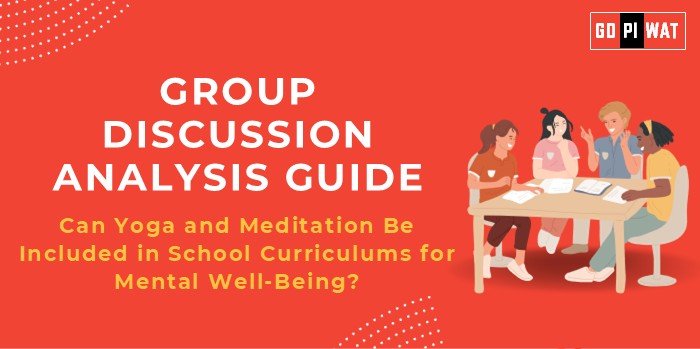📋 Group Discussion Analysis Guide
🧘 Topic: Can Yoga and Meditation Be Included in School Curriculums for Mental Well-Being?
🌐 Introduction to the Topic
Opening Context: Mental health challenges among students are rising globally due to academic pressures, social issues, and digital distractions. Introducing yoga and meditation in school curriculums can potentially enhance mental resilience and emotional stability.
Topic Background: Yoga, originating in ancient India, and meditation practices have long been valued for mental and physical well-being. In recent years, educational institutions worldwide are exploring these practices to combat stress and promote holistic growth among students. The National Education Policy 2020 in India advocates for integrating such wellness practices into formal education.
📊 Quick Facts and Key Statistics
- Student Anxiety Rates: 1 in 5 students globally faces significant anxiety levels (WHO, 2023).
- Yoga Adoption: Practiced by 300 million globally, with schools increasingly incorporating it into wellness programs.
- NEP 2020: Recommends life skills and holistic development, explicitly mentioning mindfulness techniques.
- Harvard Research: A 37% reduction in stress levels among students practicing mindfulness (2023).
- Global Examples: California’s mindfulness programs reduced classroom behavioral issues by 20%.
🤝 Stakeholders and Their Roles
- Government Agencies: Frame policies for mandatory inclusion, funding resources, and teacher training.
- Schools and Educators: Implement programs, adapt curriculums, and monitor student well-being.
- Parents: Advocate and support the adoption of these practices for children’s development.
- Nonprofits and Wellness Experts: Provide technical guidance and resources for effective implementation.
✔️ Achievements and Challenges
🌟 Achievements
- Improved Focus: Schools in Finland reported 25% better academic performance with meditation programs.
- Stress Management: Yoga reduced stress in 85% of students in CBSE-affiliated schools in India.
- Behavioral Improvements: Fewer disciplinary issues were reported post-yoga integration.
⚠️ Challenges
- Cultural Resistance: Misunderstandings around yoga’s origins may deter adoption in non-Indian contexts.
- Resource Limitations: Lack of trained instructors and funding in public schools.
- Integration Issues: Balancing academic and wellness activities within limited school hours.
🌍 Global Comparisons
- Success: New Zealand includes mindfulness in primary schools with widespread success.
- Challenges: The UK faces difficulty scaling wellness programs due to budget constraints.
📖 Case Studies
- India: Kendriya Vidyalayas have included yoga in PE periods, showing significant improvements in student alertness.
- US: California’s “Mindful Schools” initiative supports over 5,000 children annually.
💡 Structured Arguments for Discussion
- Supporting Stance: “Incorporating yoga and meditation enhances students’ mental focus, emotional intelligence, and stress management, critical for success in today’s high-pressure world.”
- Opposing Stance: “The rigid academic structure and resource constraints make integrating such programs challenging and impractical for all schools.”
- Balanced Perspective: “While yoga and meditation offer undeniable benefits, their success depends on careful implementation and addressing challenges such as funding and cultural acceptability.”
📝 Effective Discussion Approaches
- Opening Approaches:
- “With 1 in 5 students facing significant stress, yoga and meditation can transform education into a holistic experience.”
- “The success of mindfulness in New Zealand’s schools shows the potential for mental health integration globally.”
- Counter-Argument Handling:
- Rebut claims of impracticality with examples of scalable models (e.g., California’s Mindful Schools).
- Emphasize cost-effectiveness compared to long-term mental health treatment expenses.
🔍 Strategic Analysis of Strengths and Weaknesses
- Strengths: Proven benefits in stress reduction, global success stories.
- Weaknesses: Limited resources, cultural resistance in diverse regions.
- Opportunities: Technology-based mindfulness apps for scalability.
- Threats: Resistance from traditionalists and administrative bottlenecks.
📊 Connecting with B-School Applications
- Real-World Applications: Designing scalable wellness programs for corporate environments; analyzing the cost-benefit of preventive mental health strategies in HR.
- Sample Interview Questions:
- “How can mindfulness practices improve workplace productivity?”
- “Discuss the role of mental health initiatives in education reform.”
- Insights for Students: Explore mindfulness for enhancing personal leadership; research the economic impact of mental well-being programs.


